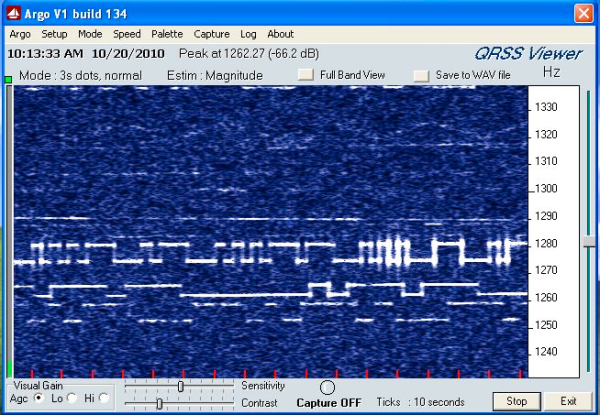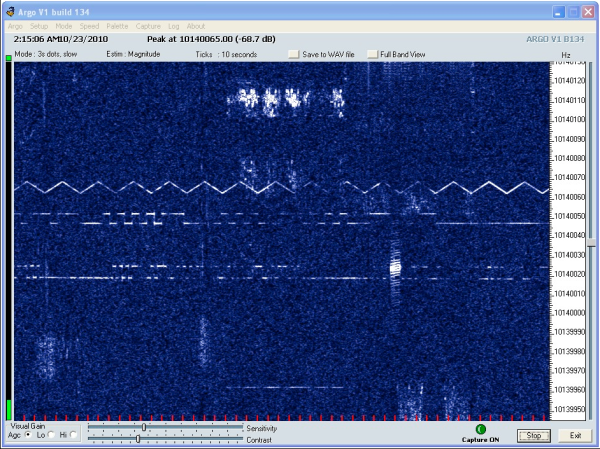Posts Tagged ‘qrss’
 New WSPR / QRSS beacon kit
New WSPR / QRSS beacon kit
Hans Summers (G0UPL) and Steve Farthing (G0XAR) have recently begun selling a new kit for a QRPp (150mW) beacon that can generate Hellschreiber, various QRSS modes and best of all WSPR. Unlike the ones now sitting unused in a drawer in G4ILO’s shack which have my details programmed in, the Ultimate QRSS Transmitter Kit has a user interface with an LCD panel that allows you to input your own callsign, locator and power output. This means it has resale value – when you get bored you can sell it on and the new owner can program it with his own details.
At the moment, kits are only available for the 30m, 40m and 80m bands, though they can also generate an audio signal that can be used to drive an SSB transmitter.
I asked Hans if they were going to offer a version for 20m, which has become one of the most popular WSPR bands. His reply was that the kits will actually work fine on any frequency between 1MHz and 20MHz, they just require a different crystal and different components in the low pass filter.
A 20m beacon for WSPR would need a 14.097MHz crystal. I searched my junkbox and couldn’t find one. Nor could I find a source for one and having one specially made would be expensive. Perhaps if there is enough demand for a 20m version it will be worth Hans and Steve’s while to have a batch made which will be cheaper.
 Propeller does WSPR
Propeller does WSPR
Through Eldon, WA0UWH I have discovered another blog to add to the blogroll: that of Jeff, KO7M. Jeff is interested in a lot of the same things I have been (including light aviation: an ambition of mine when I was in my 20s but which I could never afford to take up.) But what really piqued my interest was that he has just got a Parallax Propeller to generate a WSPR signal.
This is one of the things I was interested in trying. But I never got further than wondering how to implement the fractional frequency shifts of the WSPR signal, which uses 4 tones shifted by just under 1.5Hz from each other. Jeff has apparently found that a 2Hz shift is good enough to be decoded, allowing WSPR to be sent using the integer frequencies the Propeller chip can easily generate.
Once I have finished the Tiny Keyer project and can get back to the Propeller I will be trying this myself. My ambition at the moment is to make a multi-band multi-mode (OPERA, WSPR and perhaps QRSS as well) standalone beacon with an LCD panel to enable me to choose the band and mode. We’ll see how far I get, but having two other people working on the same ideas should certainly make the task easier!
 Operatic triumph
Operatic triumph
A new version of the Opera software has just been released which can output the bit code of a beacon signal so it can be programmed into a microcontroller such as a PIC or a Parallax Propeller chip. (You can find the download via the Links page of the Opera Yahoo group.)
I modified Eldon Brown WA0UWH’s QRSS program code to send the bit code generated by the Opera software and it was received by my K3 on 30m and successfully decoded. Not bad for 5 minutes’ work! You can download the code here.
Just as Eldon did I will have to build an amplifier to raise the output of the Propeller from a couple of milliwatts to something with a better chance of being received. Before it is worth doing that people will have to start using the Opera mode on the HF bands because with my antenna restrictions I have no hope of receiving or radiating a signal on LF or VLF. But I am quite excited at the possibility of building simple standalone beacon transmitters for this new weak signal mode which is much easier to generate than WSPR or QRSS.
Stop press: Just decoded G0NBD on 10.135MHz +1500Hz for my first real over-the-air Opera spot. And it appears my first transmission (using the PC software and my K3 at 5W) has been received by OM5NA at -21dB. This is fun!
 First spin of the propeller
First spin of the propeller
A new toy dropped through the letterbox today. It is a Gadget Gangster Propeller Platform USB demo board for experimenting with the Parallax Propeller microcontroller. If you haven’t heard of the Parallax Propeller before then it is an inexpensive micro chip that contains eight processors called cogs (as in gear wheels) that can run independently in parallel. It’s quite a bit different from the Microchip PIC or Atmel devices which have a single processor architecture similar to an ordinary computer.
I sent off for the board just after Christmas, after reading about it in Eldon Brown WA0UWH’s blog. Eldon posted code showing how the board could be used as a QRSS beacon. I was quite excited by the idea of a device that with simple programs even I could understand could be made to emit RF.
I sent off for the board on 27th December choosing the low cost untracked USPS air mail shipping option and it arrived today, 4 January – much quicker than expected. What’s more, there were no nasty customs charges! Gadget Gangster still has a special offer of $10 off for the board, so if you fancy getting one of these to play with now is the time to do something about it.
I was very impressed at the speed with which Gadget Gangster processed my order. What you get, though, is just the board. You will need to provide a power supply (7.5 – 12V with a 2.1mm barrel connector, centre positive) and a USB cable with a mini-USB jack at one end. These seem to breed in my junk box so that was not a problem. You will also find useful a small breadboard and some hookup wire to attach components to the board and test your programs.
I installed the Propeller Tool – a free download from the Parallax website, connected the board to my Samsung NC10 netbook. I then tried the Blinky Light tutorial from the Gadget Gangster site. It didn’t work – until I connected the LED the correct way round (stupid newbie error!)
Over the next few days I’ll be working through the tutorials to get the hang of the system. Then I’ll take a look at Eldon’s QRSS beacon code and adapt it to send my own call. I’d like to make a WSPR beacon. I don’t know yet if that will be possible, but I’m looking forward to playing with this Propeller chip and using it in some radio-related project. Watch this space!
 Beacon of hope
Beacon of hope
These last few days have been surreal. I don’t feel like a man with a time bomb in my head. I’m still weak, tired and find concentration difficult (the ability to get some decent sleep would help) but every day seems to bring an improvement in many functions. I’m even typing more accurately than I’ve done in a long time. I suppose it’s possible this brain tumour was having an effect on things before I even became aware of it.
I’m far from feeling up to spending a lot of time on the hobby (or anything else in particular) but my mind still needs things to occupy it and my links and contacts with the ham radio community help lift my spirit. As I’m not using my magnetic loop antenna I thought I would connect up the 30m QRSS beacon I built last autumn. So my callsign will be going out over the airwaves as a sign that I’m down but not out and not giving in to the doctors’ pessimistic predictions.
I’d appreciate reception reports direct to my email (julian . g4ilo at gmail . com). At the moment I can’t make head nor tail of grabbers. Nor can I figure out how to change my entry on the Knights QRSS Clipboard. A long way still to go, then, but at least progress for the moment is in the right direction.
73 and thanks for all the messages of support. They really were appreciated during this awful week. If you are interested, you can follow my progress with treatment in One Foot in the Grave.
 Two more QRSS reception reports
Two more QRSS reception reports
Here are two more recent reception reports of my QRSS signal.
Steve, N8YE, sent one from South Eastern Ohio (above) from 20th Oct 2010 and my signal looks nice and strong. Also, I saw the my signal this evening in KL7UK/5 Bartlesville OK grabber (see below).
 Spotted in Spain
Spotted in Spain
My 30m 50mW QRSS signal has now been received in Spain by the grabber of EA1FAQ. (It’s the one at 10140.030 kHz.)
That’s a distance of 1458km or 906 miles.
[Off-topic note: When will Blogger fix its frigging “Add Images” uploader so it works in Firefox? I had to use the ghastly IE to insert the picture.]
















